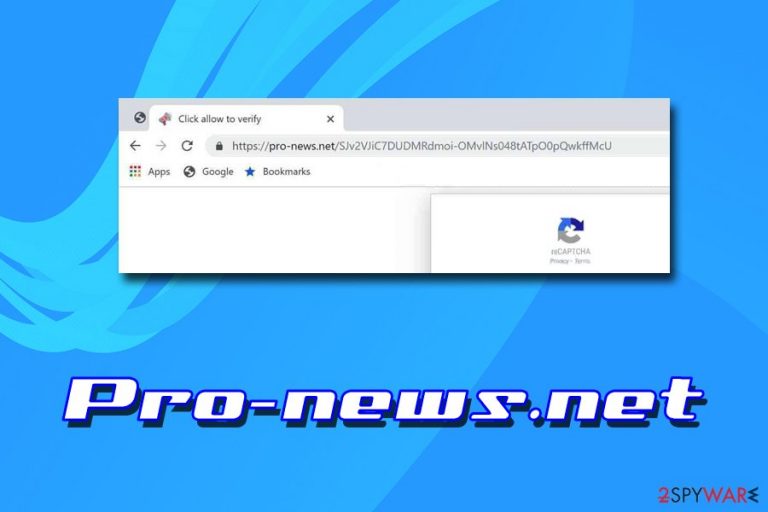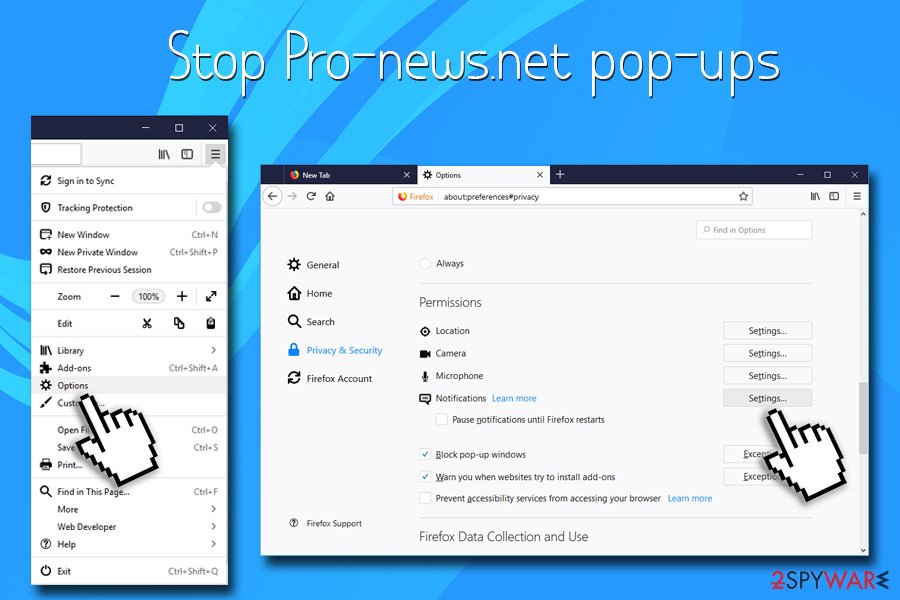Pro-news.net (Removal Instructions) - Chrome, Firefox, IE, Edge
Pro-news.net Removal Guide
What is Pro-news.net?
Pro-news.net is a suspicious website that serves a variety of ads and redirects to potentially dangerous sites

Pro-news.net is a push notification virus that also redirects users to questionable websites and displays pop-ups, banners, promotional offers, deals, in-text links, flashing windows and similar commercial content on Google Chrome, Mozilla Firefox, Safari, Opera or other browsers.
If you noticed that Pro-news.net redirects and pop-ups do not leave your browser, it is highly likely that your device is infected with adware.[1] These potentially unwanted programs typically alter web browser settings to expose users to various ads and track their web browser activities for targeted advertising[2] purposes.
You can remove Pro-news.net pop-ups and redirects by terminating adware that is installed on your system. Additionally, you can also stop notifications by changing settings of your browser or resetting it all together. For more detailed instructions, please check the bottom section of the article.
| Name | Pro-news.net |
| Type | Adware/Potentially unwanted program |
| Infiltration | Software bundling, third-party sites, ads |
| Symptoms | Redirects to |
| Risk factors | Malware infections, sensitive data leakage to unknown parties, money loss |
| Deletion | Terminate adware with security software or by using manual guide below |
| Recovery | To restore your system to previous state and improve its operation, scan it with FortectIntego |
Potentially unwanted programs like Pro-news.net usually get installed together with freeware or shareware that you download from the internet (generally from third-party sites). Alternatively, some applications might have an adware component included within its functionality, and you might not even know about it. Thus, it is always worth reading reviews online before installing any type of program you are not familiar with.
While the advertisement is a genuine income option for multiple website and software developers, the matter becomes much more serious when ad-supported apps may compromise its users' safety. Therefore, while considered nowhere near as dangerous as trojan, ransomware or an info-stealer, Pro-news.net and similar adware might lead to the installation of that said malware, especially if not handled carefully.
Pro-news.net might lead users to tech support scam, phishing, or even malware-laden websites. Therefore, it is vital not to click on anything and swiftly close down the browser. Only after Pro-news.net removal, you should resume web browsing activities.

In addition to all this, Pro-news.net virus might track the following data:
- IP address;
- Search queries;
- ISP;
- Sites visited;
- Links clicked;
- Cookies;
- Bookmarks added;
- Technical details, etc.
Be aware that the IP address is considered personal information, along with search queries that you enter into the search engine. Thus, your private details, such as name, email, address, etc. might get leaked and exposed to unknown parties.
After you eliminate adware, security experts[3] strongly recommend scanning the device with FortectIntego for a quick recovery.
Bundled software may lead to adware and other PUP infections
If you are wondering how a potentially unwanted program got into your device, and why you have not noticed the point of entry, the answer is simple – it is because you installed an application without paying close attention to its installation instructions. While software bundling technique is far from fair, it is also users' responsibility to make sure not PUPs slip in during the installation.
To avoid future infections, do not rush the installation process and read through the instructions carefully. Be aware that freeware authors often use tricks to hide potentially unwanted programs, such as pre-ticked boxes, misleading or grayed out buttons, carefully hidden offers, etc.
Thus, always pick Advanced/Custom settings and terminate all the optional components from the install list, such as system optimizers, driver updaters, PDF converters, toolbars, etc.
Stop Pro-news.net redirects and popups with the help of these instructions
If you are continually suffering from redirects and ads, you should remove Pro-news.net virus from your computer to stop the invasive activity. You can do that either manually or automatically – both methods work, but the former might be less effective in some cases. If you go with the latter, download a reputable security tool and perform a full system scam.
In case redirects and pop-ups do not cease even after Pro-news.net removal, you need to stop notifications from being shown from unwanted sources. To do that, please follow these instructions:
Google Chrome
- Go to Menu and select Settings
- Pick Advanced and then go to Privacy and security > Content Settings > Notifications
- Now find Pro-news.net (or any other that you do not recognize) entry under Allow
- Select More Actions and then click on Block
Mozilla Firefox:
- Go to Menu and select Options
- Pick Privacy & Security > Notifications

- Select Settings and determine the unwanted entries, including the Pro-news.net one
- From the drop down menu, pick Block
Safari:
- Click on Safari and then pick Preferences > Notifications
- Select Deny under Pro-news.net
MS Edge:
- Select More and pick Settings
- Click on View advanced settings
- Find Pro-news.net and then turn off notifications
You may remove virus damage with a help of FortectIntego. SpyHunter 5Combo Cleaner and Malwarebytes are recommended to detect potentially unwanted programs and viruses with all their files and registry entries that are related to them.
Getting rid of Pro-news.net. Follow these steps
Uninstall from Windows
To remove Pro-news.net pop-up ads form Windows OS, follow these steps:
Instructions for Windows 10/8 machines:
- Enter Control Panel into Windows search box and hit Enter or click on the search result.
- Under Programs, select Uninstall a program.

- From the list, find the entry of the suspicious program.
- Right-click on the application and select Uninstall.
- If User Account Control shows up, click Yes.
- Wait till uninstallation process is complete and click OK.

If you are Windows 7/XP user, proceed with the following instructions:
- Click on Windows Start > Control Panel located on the right pane (if you are Windows XP user, click on Add/Remove Programs).
- In Control Panel, select Programs > Uninstall a program.

- Pick the unwanted application by clicking on it once.
- At the top, click Uninstall/Change.
- In the confirmation prompt, pick Yes.
- Click OK once the removal process is finished.
Delete from macOS
Remove items from Applications folder:
- From the menu bar, select Go > Applications.
- In the Applications folder, look for all related entries.
- Click on the app and drag it to Trash (or right-click and pick Move to Trash)

To fully remove an unwanted app, you need to access Application Support, LaunchAgents, and LaunchDaemons folders and delete relevant files:
- Select Go > Go to Folder.
- Enter /Library/Application Support and click Go or press Enter.
- In the Application Support folder, look for any dubious entries and then delete them.
- Now enter /Library/LaunchAgents and /Library/LaunchDaemons folders the same way and terminate all the related .plist files.

Remove from Microsoft Edge
Delete unwanted extensions from MS Edge:
- Select Menu (three horizontal dots at the top-right of the browser window) and pick Extensions.
- From the list, pick the extension and click on the Gear icon.
- Click on Uninstall at the bottom.

Clear cookies and other browser data:
- Click on the Menu (three horizontal dots at the top-right of the browser window) and select Privacy & security.
- Under Clear browsing data, pick Choose what to clear.
- Select everything (apart from passwords, although you might want to include Media licenses as well, if applicable) and click on Clear.

Restore new tab and homepage settings:
- Click the menu icon and choose Settings.
- Then find On startup section.
- Click Disable if you found any suspicious domain.
Reset MS Edge if the above steps did not work:
- Press on Ctrl + Shift + Esc to open Task Manager.
- Click on More details arrow at the bottom of the window.
- Select Details tab.
- Now scroll down and locate every entry with Microsoft Edge name in it. Right-click on each of them and select End Task to stop MS Edge from running.

If this solution failed to help you, you need to use an advanced Edge reset method. Note that you need to backup your data before proceeding.
- Find the following folder on your computer: C:\\Users\\%username%\\AppData\\Local\\Packages\\Microsoft.MicrosoftEdge_8wekyb3d8bbwe.
- Press Ctrl + A on your keyboard to select all folders.
- Right-click on them and pick Delete

- Now right-click on the Start button and pick Windows PowerShell (Admin).
- When the new window opens, copy and paste the following command, and then press Enter:
Get-AppXPackage -AllUsers -Name Microsoft.MicrosoftEdge | Foreach {Add-AppxPackage -DisableDevelopmentMode -Register “$($_.InstallLocation)\\AppXManifest.xml” -Verbose

Instructions for Chromium-based Edge
Delete extensions from MS Edge (Chromium):
- Open Edge and click select Settings > Extensions.
- Delete unwanted extensions by clicking Remove.

Clear cache and site data:
- Click on Menu and go to Settings.
- Select Privacy, search and services.
- Under Clear browsing data, pick Choose what to clear.
- Under Time range, pick All time.
- Select Clear now.

Reset Chromium-based MS Edge:
- Click on Menu and select Settings.
- On the left side, pick Reset settings.
- Select Restore settings to their default values.
- Confirm with Reset.

Remove from Mozilla Firefox (FF)
Do not forget to refresh Mozilla Firefox after you terminate the PUP:
Remove dangerous extensions:
- Open Mozilla Firefox browser and click on the Menu (three horizontal lines at the top-right of the window).
- Select Add-ons.
- In here, select unwanted plugin and click Remove.

Reset the homepage:
- Click three horizontal lines at the top right corner to open the menu.
- Choose Options.
- Under Home options, enter your preferred site that will open every time you newly open the Mozilla Firefox.
Clear cookies and site data:
- Click Menu and pick Settings.
- Go to Privacy & Security section.
- Scroll down to locate Cookies and Site Data.
- Click on Clear Data…
- Select Cookies and Site Data, as well as Cached Web Content and press Clear.

Reset Mozilla Firefox
If clearing the browser as explained above did not help, reset Mozilla Firefox:
- Open Mozilla Firefox browser and click the Menu.
- Go to Help and then choose Troubleshooting Information.

- Under Give Firefox a tune up section, click on Refresh Firefox…
- Once the pop-up shows up, confirm the action by pressing on Refresh Firefox.

Remove from Google Chrome
Delete malicious extensions from Google Chrome:
- Open Google Chrome, click on the Menu (three vertical dots at the top-right corner) and select More tools > Extensions.
- In the newly opened window, you will see all the installed extensions. Uninstall all the suspicious plugins that might be related to the unwanted program by clicking Remove.

Clear cache and web data from Chrome:
- Click on Menu and pick Settings.
- Under Privacy and security, select Clear browsing data.
- Select Browsing history, Cookies and other site data, as well as Cached images and files.
- Click Clear data.

Change your homepage:
- Click menu and choose Settings.
- Look for a suspicious site in the On startup section.
- Click on Open a specific or set of pages and click on three dots to find the Remove option.
Reset Google Chrome:
If the previous methods did not help you, reset Google Chrome to eliminate all the unwanted components:
- Click on Menu and select Settings.
- In the Settings, scroll down and click Advanced.
- Scroll down and locate Reset and clean up section.
- Now click Restore settings to their original defaults.
- Confirm with Reset settings.

Delete from Safari
Remove unwanted extensions from Safari:
- Click Safari > Preferences…
- In the new window, pick Extensions.
- Select the unwanted extension and select Uninstall.

Clear cookies and other website data from Safari:
- Click Safari > Clear History…
- From the drop-down menu under Clear, pick all history.
- Confirm with Clear History.

Reset Safari if the above-mentioned steps did not help you:
- Click Safari > Preferences…
- Go to Advanced tab.
- Tick the Show Develop menu in menu bar.
- From the menu bar, click Develop, and then select Empty Caches.

After uninstalling this potentially unwanted program (PUP) and fixing each of your web browsers, we recommend you to scan your PC system with a reputable anti-spyware. This will help you to get rid of Pro-news.net registry traces and will also identify related parasites or possible malware infections on your computer. For that you can use our top-rated malware remover: FortectIntego, SpyHunter 5Combo Cleaner or Malwarebytes.
How to prevent from getting adware
Choose a proper web browser and improve your safety with a VPN tool
Online spying has got momentum in recent years and people are getting more and more interested in how to protect their privacy online. One of the basic means to add a layer of security – choose the most private and secure web browser. Although web browsers can't grant full privacy protection and security, some of them are much better at sandboxing, HTTPS upgrading, active content blocking, tracking blocking, phishing protection, and similar privacy-oriented features. However, if you want true anonymity, we suggest you employ a powerful Private Internet Access VPN – it can encrypt all the traffic that comes and goes out of your computer, preventing tracking completely.
Lost your files? Use data recovery software
While some files located on any computer are replaceable or useless, others can be extremely valuable. Family photos, work documents, school projects – these are types of files that we don't want to lose. Unfortunately, there are many ways how unexpected data loss can occur: power cuts, Blue Screen of Death errors, hardware failures, crypto-malware attack, or even accidental deletion.
To ensure that all the files remain intact, you should prepare regular data backups. You can choose cloud-based or physical copies you could restore from later in case of a disaster. If your backups were lost as well or you never bothered to prepare any, Data Recovery Pro can be your only hope to retrieve your invaluable files.
